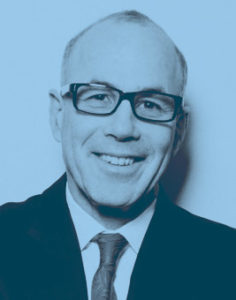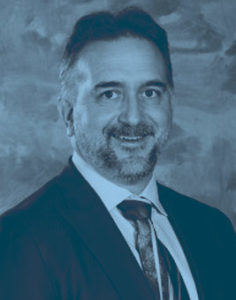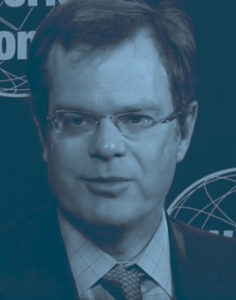
Changing Your Healthcare Organization Might Just Take a “Mini Tempest”
Thousands of healthcare executives sat in rows of upholstered chairs, waiting in the basement-level ballroom of Chicago’s Hyatt Regency hotel for Marc Harrison, M.D., CEO of Intermountain Healthcare, to say something revelatory about leading through trying times.

Harrison
Harrison is famously forward-thinking, and Intermountain, a 23- hospital Utah-based system, is known for its agility. The audience was ready for him to deliver a keynote with Steve Klasko, M.D., CEO of Jefferson Health – a system with five locations in Philadelphia and New Jersey – at the Becker’s Hospital Review 10th Annual Meeting in April.
“Disrupt yourselves,” Harrison told the thousands of executives. “Stop making yourselves so damn comfortable and start serving the people you’re supposed to serve.”
He may have sounded harsh, but healthcare organizations are in dire need of change. Good leaders know this and are already looking ahead. Many realize they must turn into something different, rework their business models and provide new services.

Klasko
“We recognize that hospital beds are going to be a commodity,” Klasko said onstage at Becker’s. “And the antidote to commoditization is differentiation and diversification.”
Health systems are diversifying in a number of ways. Some, like Jefferson Health, are commercializing new technologies and therapies. Others, such as San Francisco-based Dignity Health, are laser-focusing on population health. Regardless of the action, many have long predicted the need to change.

Hochman
“Six years ago, we saw that if we stayed on our traditional path of just taking care of patients, it wasn’t sustainable,” said Rod Hochman, M.D., CEO of non-profit Catholic health system Providence St. Joseph Health, speaking at the conference. “We had to rethink how we could create revenue from things other than patient care.”
Hochman and his team took several steps. They built a division of public health, hired a chief digital officer to focus on the consumer experience and started to move more services to ambulatory units.
“Chefs talk about deconstructing food,” he said. “We’re deconstructing the health system to make it lighter, more agile and able to compete.”
Not only do health systems have to morph, but companies that partner with systems are also having to change their business models. Nashville-based Premise Health, for example, started as a company that worked with employers to provide on-site clinics. But, their partners expected more.

Clark
“Employers are asking us to now bring the community into alignment,” says Stu Clark, the company’s CEO. “They’re asking Premise to form networks of high-quality providers and only refer to them.”
Clark says, “We’ve gone from just providing convenient care onsite for workers to operating full-fledged primary care centers for the whole family – onsite and nearsite in the communities, with complementary lines of service like pharmacy, physical therapy, behavioral health, fitness and biometric screening.”
Those are fundamentally different tasks that require different asks of the organization. And the circumstances forcing the evolution at Premise exist across the healthcare industry.
In other words, there’s no question that healthcare organizations need to change. The question is how.
Unleashing “Mini Tempests”
When Intermountain’s Harrison referred to the comfort of the people in his audience, he called out one of the main barriers to organizational change: inertia.

Forrest
“Have you ever heard about cultural entropy?” asks Arick Forrest, M.D., president of The Ohio State University Physicians and vice dean of clinical affairs for The Ohio State University College of Medicine. “People go to the lowest common denominator – they’re just trying to get through the day. You have to fight that entropy all the time to make them want to get better.”
Cultural entropy can stagnate an organization, he says. “If you have a bunch of employees and physicians who just want to punch the clock, you’re never going to be a high-performing institution. That’s not a viable business model – you’re never going to succeed.”
But even if healthcare leaders know the consequences of inaction, it’s important that doctors, nurses, clinicians and frontline staff understand too. For them, the problems with the day-to-day system may not yet warrant the pain of change.

Singh
“It’s very difficult to change from a place of, ‘Well, it’s always been this way, and now we have to change,’” said Anu Singh, managing director at Kaufman Hall. “Sometimes what it takes is for an organization to have a significant event – sometimes negative, sometimes positive – for people to say, ‘Boy, we better rethink everything we’re doing.’”
When there isn’t a significant event, Singh says, leaders can still create a sense of urgency, using a series of smaller, urgent changes, tied to specific goals and timelines.
For this model to work, leaders must put their money where their mouth is. And, since time is money, that means investing their time in ideas that will change their organizations.
“It’s okay if the entire board meeting is 80 percent blocking and tackling, that’s fine,” says Singh. “But if 20 percent isn’t cut out to say, ‘Well, how do we think about things creatively?’ then you’re almost self-perpetuating this mindset of, ‘Let’s just do what we did last year.’”
We are the Champions
Innovative leaders alone cannot shoulder the work of changing an organization. They must create space to think differently, and that’s important. Then, to carry out their ideas, they must activate others.

Schreiner
“You’ve got to have the people on the front lines and you need to have the senior leaders singing the same song. It’s a classic ‘and-not-or’ scenario. If either side fails in that positive communication, it will fail,” says Dave Schreiner, CEO of KSB Hospital, an 80-bed facility in Dixon, Illinois.
With this alignment, change is possible – even the type of change everybody dreads. Schreiner offers the example of his hospital’s recent EMR rollout.
“No one says, ‘Thank you for changing my EMR,’” says Schreiner, “They’re really hard, and they touch so many people.”
To start the work, Schreiner asked his leadership team to explain to employees that KSB was investing in training and technology upfront for a payoff down the line. At the same time, he says, “We went to our department directors to find champions. We were looking for people with a little bit of technological skill and a whole lot of informal leadership traits. We said, ‘Let’s make these people heroes. Let’s give them t-shirts and buy them lunches’ – whatever we can do to put a spotlight on them.”
Not only did this help smooth the EMR rollout, Schreiner says, but he and his team were surprised by the internal leaders they found. Far from being a Millennial-driven project, several seasoned leaders throughout KSB became EMR champions. One senior nurse on the medical surgical floor had experienced a previous rollout and wanted control over the new process. Not only did the hospital discover an untapped resource in these employees, Schreiner says, but they became more engaged. “They feel good about helping and fixing.”
Check Your Culture
Schreiner’s story exemplifies a critical issue in organizational change: that is, the way people feel about change is just as important, if not more so, than the change itself. And the way people feel about change is tied to culture.

Alhadeff
“The culture of a group of people is their shared beliefs, their attitude and how they are going to address different problems,” said Joseph Alhadeff, M.D., President of Pennsylvania-based orthopedic surgery group OSS Health, speaking at Becker’s. “The culture of an organization is how people interact with one another, and that’s what makes it so difficult to change.”
Changing the culture is daunting anywhere, but especially at large, complex health systems.

Woodson
“There’s a tendency to want to think of health systems as one organization with one culture, but the reality is there are many sub-cultures and micro cultures,” says Bill Woodson, senior vice president at the Illinois-based healthcare consultancy Sg2. “To do the day-to-day change management leadership, you need some sensitivity that you’re dealing with a whole bunch of different cultures at the same time.”
The good news, he says, is that even though healthcare organizations are a conglomerate of sub-cultures, there is a common ethic. “The heart of why people stay in the healthcare profession is still noble and powerful,” Woodson says. The best leaders, he adds, not only understand that, but also share the same motivation and tap into it among others.
The only way to motivate people is through clear, consistent, two-way communication. One tactic that OSS’ Alhadeff has found helpful is to scrap the annual employee evaluation.
“That yearly evaluation creates all sorts of stress,” he said. “Instead, we try to get to get consistent feedback on a weekly or monthly basis. That’s much more effective – it’s hard to do, it requires a lot of work. But if you have that ongoing communication you don’t need that formal evaluation once a year. When things are going sideways, I want my staff to tell me about it right away.”
Constant communication also creates a feedback loop that empowers staff, which is critical. Empowered staff, research shows, tend to provide better care, according to Alhadeff.
“Patients don’t always have a choice of where to go, but when they do, they tend to gravitate towards places with healthier cultures.”
Ego is the Enemy
The number-one killer of a healthy culture is ego.
“There is no room for the ego-driven, command-and-control management structure of the past,” says Premise Health CEO Stu Clark. Any organization that employs that won’t last.”
“We have an environment here that insists leaders are ego-less. I tell my team that arrogance and insecurity are twins,” he says. “All of us have our insecurities but arrogance can be controlled. When I see arrogance exhibited, it doesn’t last very long.”

Marotta
Greg Marotta, CEO of Nashville-based outpatient addiction treatment provider CleanSlate Centers, echoes the sentiment. He says organizations that need to change must do three things well. First, they need to tell a story that relates to the purpose of their organization. Second, they have to engage their associates. Third, they have to set clear goals.
Key elements for organizational change, he says, are old-fashioned relationship building, communication and teamwork.
“What gets in the way?” he asks: “Ego.”
Marotta continues, “For successful organizations, it’s about your purpose, it’s about your why. It’s not about individual agendas. It’s not about titles and roles. It’s not about what you have experienced in prior organizations, it’s about using what you learn from those experiences in a way that can change the current organization.”
Reframing Change
Finally, the best organizational change leaders approach the issue with a different lens. Though change might be painful, they see it as the norm.
“I have a little saying that I use with the physicians and some of the employees: If you don’t like change, you’ll like irrelevance even less,” says OSU’s Forrest.
“Everyone’s so anti-change, but I just point out to people that you change every single day. Everything in your life is evolving, you just don’t think of it as change. It may not be easy, but it is certainly true that in order to improve, you absolutely have to change.”
The most forward-thinking leaders are living this out as we speak. As Harrison told the packed room at Becker’s this Spring, Intermountain Health has been in a state of constant motion and will be for the foreseeable future. The system recently changed its cost structure, though it wasn’t easy.
“And we’re innovating in a very rigorous, organized fashion to understand what levers we need to pull to keep at-risk populations well,” Harrison said. “We are decreasing the cost of shoppable procedures.”
He paused, looked at the crowd and added, “This is all possible by all of you if you break your addiction to fee-for-service revenue.”
But whatever major organizational change the attendees were planning, he urged them to undertake it. “You all have to make the transformation now, when you’re strong enough to afford it.”
